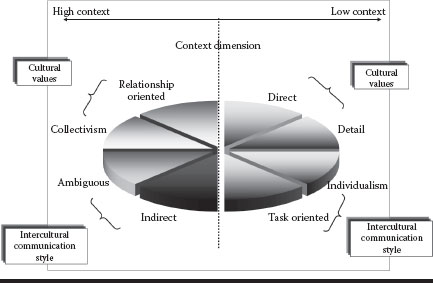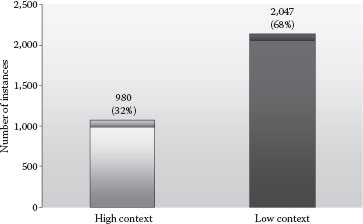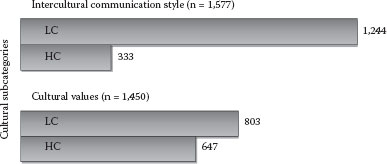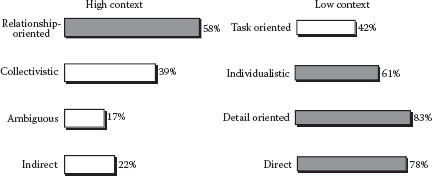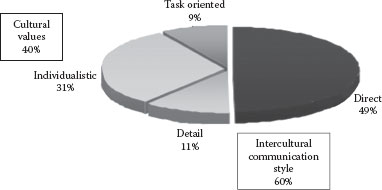Online Communicative Behaviors Based on Cultural Variations
Fundamentally, people exhibit different choices, styles, and strategies in decision making based on their culture; these differences are particularly striking between high- and low-context communication styles. The general difference in decision strategy is between detailed and agreed-upon decisions versus shallow information exchanges. Adler (1997) also examined other decision-making issues, such as whether decisions are made quickly or slowly and whether information and alternatives are discussed sequentially or holistically. These different approaches appear in various locations along the high-context/low-context continuum. Therefore, the main purpose of this chapter is to provide a brief and broad understanding on the following research question:
Are there discernible patterns of cultural variations evident in the email messages that were exchanged among the Civil Society GVT members? If so, is Hall’s high-context versus low-context dimension sufficient to explain these variations?
Results are presented based on the cultural dimension of context: high context and low context. For each end of the spectrum, the findings are further analyzed based on two variables: (1) intercultural communication style and (2) cultural values, which will be presented in Chapters 12 and 13. Specifically, for high-context participants, intercultural communication styles were analyzed based on constructs like indirectness and ambiguity, while cultural values were analyzed based on collectivism versus relationship oriented. For low-context participants, intercultural communication styles were analyzed based on constructs like direct and detail oriented, while cultural values were looked at in terms of individualism and task oriented (see Figure 11.1).
The findings from this study clearly show that there are discernible patterns of culture based on high- and low-context orientation. These cultural variations were evident in the messages that were posted by Civil Society participants when they engaged in decision-making activities. The overall proportion of high- and low-context behaviors (see Figure 11.2) were strikingly different with 68% of the instances representing low-context behaviors (n = 2,047) and only 32% representing high-context behaviors (n = 980).
Figure 11.1 Context cultural dimension.
As shown in Figure 11.3, further analysis revealed more instances of intercultural communication styles (52% of total occurrences, n = 1,577) than of cultural values (48%, n = 1,450). Analyzing across cultural categories, a significant behavioral pattern was observed in the high- and low-context participants’ intercultural communication styles. Low-context communication style accounted for 79% (n = 1,244) compared to high context, which accounted for only 21% (n = 333). For cultural values, there was much less variation between the two cultural categories: low-context behaviors accounted for 55% (n = 803), while high-context behaviors accounted for 45% (n = 647).
Figure 11.2 Proportion of high-context versus low-context messages.
Figure 11.3 Cultural subcategories: intercultural communication style versus cultural values.
However, the findings within each cultural category showed more interesting divergent behavioral patterns. For high context, the number of instances for cultural values (n = 647) were almost double the number of instances of intercultural communication style (n = 333), a difference of 51%. Quite the opposite is seen in the low-context orientation: the number of instances of intercultural communication style was much higher (n = 1,244) than the number of instances of cultural values (n = 803). However, the variation was only 35% when both subcategories were considered, indicating a much lower variation overall for low context than for high context. Interestingly, both cultural categories showed a reversed pattern of cultural dominance: high context had a higher correspondence with cultural values, and low context had a higher correspondence with intercultural communication style.
The proportion of high versus low context can be broken down into four different cultural constructs, as shown in Table 11.1. Although the overall patterns revealed that low-context participants generated a higher total number of occurrences for the direct (n = 1,015), detail (n = 229), and individualistic (n = 628) constructs, task oriented had fewer occurrences (n = 175) than relationship oriented (n = 245), as reflected in Table 11.1.
Furthermore, as shown in Figure 11.4, a comparison was made across constructs; the shaded area points out the constructs that generated a higher percentage when compared in terms of high context versus low context. This analysis shows that, for high context, the relationship-oriented construct was higher, accounting for 58%, compared to task oriented, which accounted for 42% of total occurrences. The other three constructs for low context showed higher percentages than their high-context counterparts. However, what stood out in the finding is that from the low-context constructs called detail and direct. The detail construct was represented by 83% of total occurrences, while only a mere 17% was represented by the ambiguous construct from high context. Likewise, for direct, the total occurrences for low context were significantly higher (78%) than the construct of indirect for high context (only 22% of total occurrences). In essence, for the parallel comparison, the dominant construct for high context is relationship oriented, while, for low context, the dominant construct was detail and direct communication style.
Table 11.1 Overall Distribution of High-versus Low-Context Cultural Constructs

a Total percentage does not equal 100% due to rounding.
Figure 11.4 Comparison of cultural constructs for high and low context.
The following section expands on each of the cultural context orientations by detailing which cultural construct is more dominant.
Figure 11.5 Proportion of cultural constructs observed for high-context orientation.
High-Context Cultural Orientation
For the high-context cultural orientation,* collectivistic features were seen in 41% of total occurrences (see Figure 11.5). The next most prominent cultural values, indirect and relationship oriented, were seen in 29% and 25% of occurrences, respectively. In combination, these two constructs made up 54% of the total occurrences. Despite the low percentage of relationship-oriented occurrences compared to the other two high-context constructs, its occurrence was still much higher than its opposite (task oriented). Ambiguous was the least significant construct, appearing in only 5% of the voluminous number of email messages.
* The analysis was made within the high-context category, i.e., between direct and ambiguous, or between collectivistic and relationship oriented. The comparison made in the “Introduction” section (see Figure 11.3) was done across categories, i.e., high versus low context, relationship oriented versus task oriented.
For high-context cultural orientation, the dominant cultural patterns exhibited were in the cultural values, which totaled 66%. On the other hand, the two types of intercultural communication style (indirect and ambiguous) accounted for only 34% of the total high-context occurrences. In addition, indirectness and ambiguity messages (n = 333) together accounted for only 11% of all cultural occurrences (n = 3,027).
Low-Context Cultural Orientation
Results showed that low-context behaviors were reflected more in the intercultural communication style subcategory, with 60% of total low-context occurrences, than in the cultural values subcategory, with only 40% (see Figure 11.6). Notably, under the subcategory of intercultural communication style, direct accounted for 82% of the combined construct, while detail accounted for only 18%. This strongly suggests that directness is the main characteristic of low-context communications. For cultural values, individualism represented 31% of total occurrences and task oriented only 9%, indicating that individualism was the next most prominent cultural characteristic of low-context communications.
Based on the findings of GVTs in Civil Society, it could be deduced that, with cultural knowledge, organizations can identify how people initially learn to communicate given these context-based considerations: what to say (choice of words), to whom to utter such words (what the relationship is between the sender of the message and the recipient), why use such words (reasons and justifications for communicating), when it is best to be said (the timing and location of communication), and, finally, in which manner it is best said (the approaches used). On the other end of the cultural spectrum, content has a bearing on communication because words are sought after, and not context. Such culturally attuned challenges need to be learned and dealt with in the GVT context. Chapters 12 and 13 provide an in-depth description of the patterns of behaviors that are exhibited in each subcategory: intercultural communication styles and cultural values. Furthermore, each of the subcategories will be explained in terms of the cultural patterns of behaviors and supported by verbatim examples from the email messages.
Figure 11.6 Proportion of cultural constructs observed for low-context orientation.
Adler, N.J. 1997. International Dimensions of Organizational Behavior, 3rd ed. Cincinnati, OH: South-Western.

